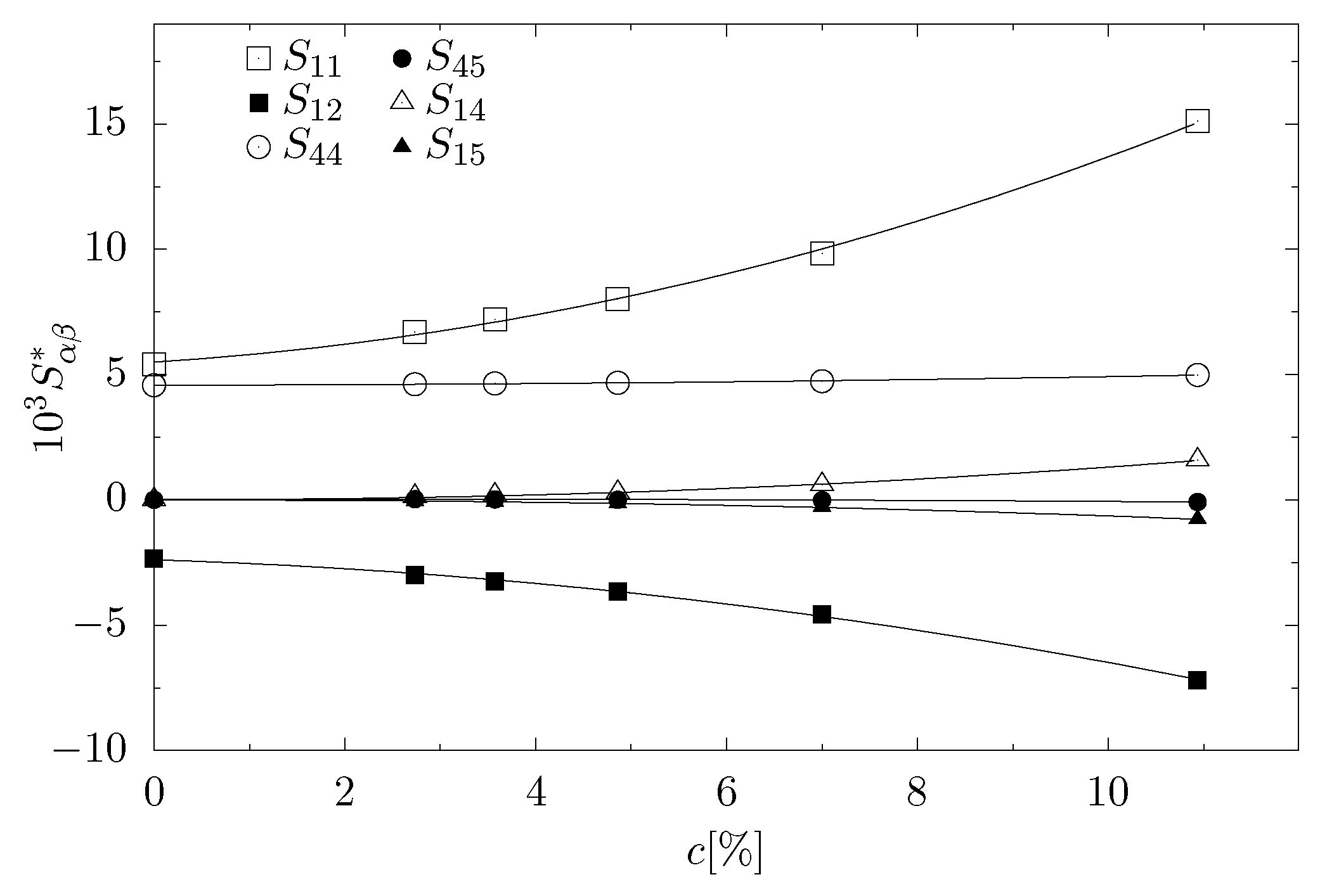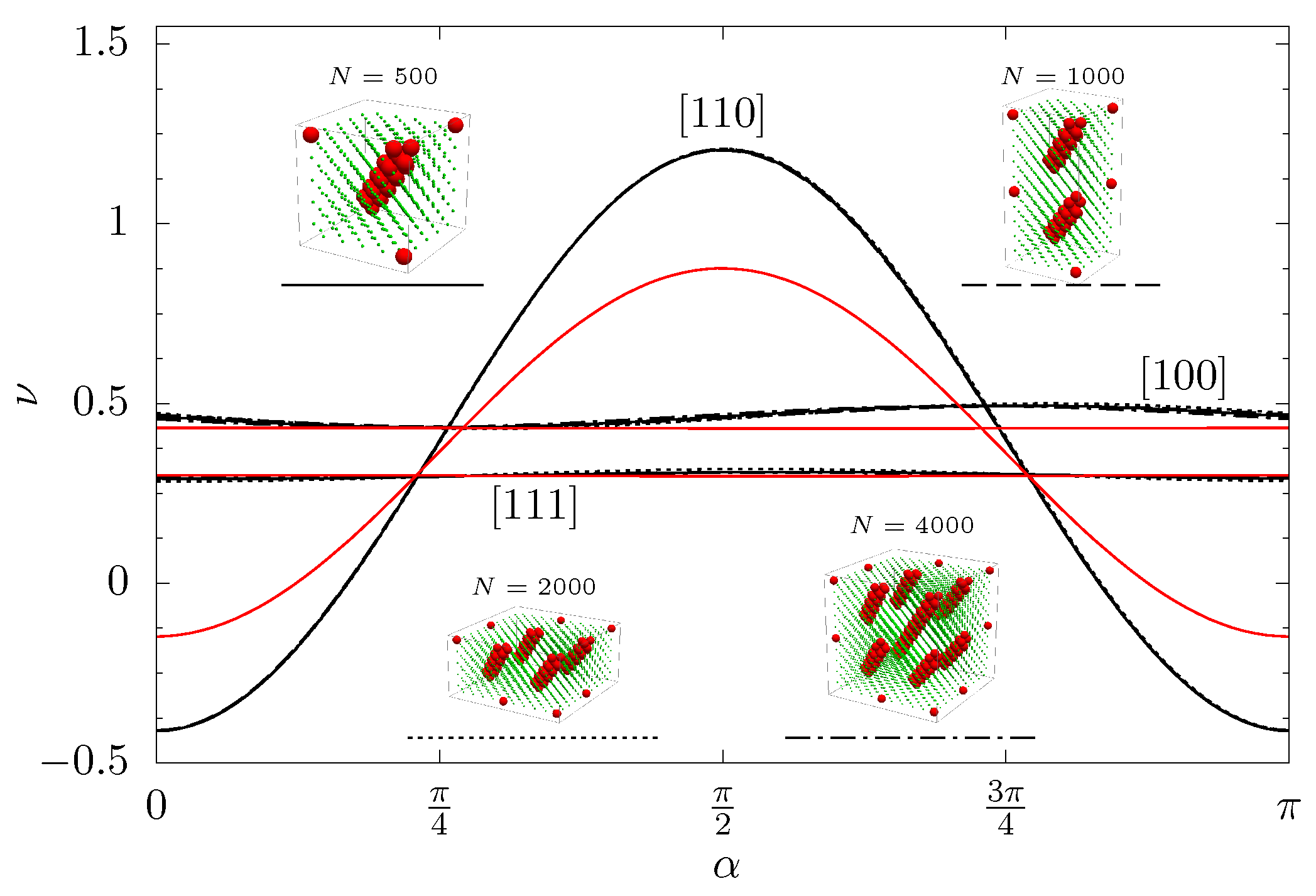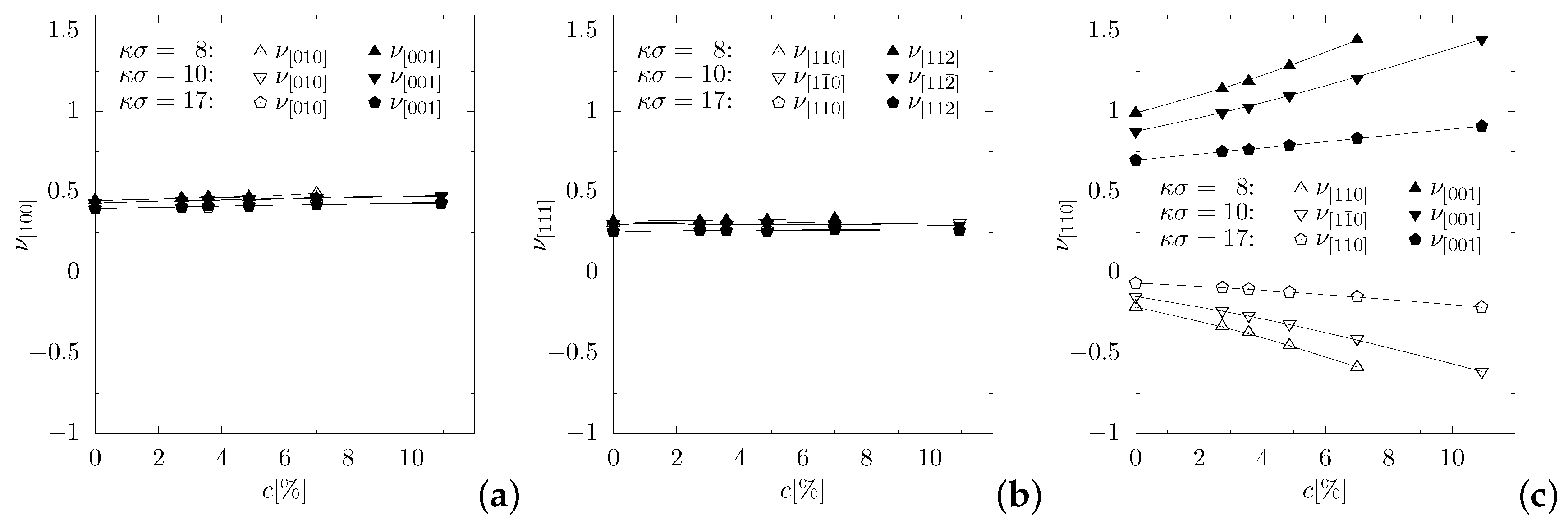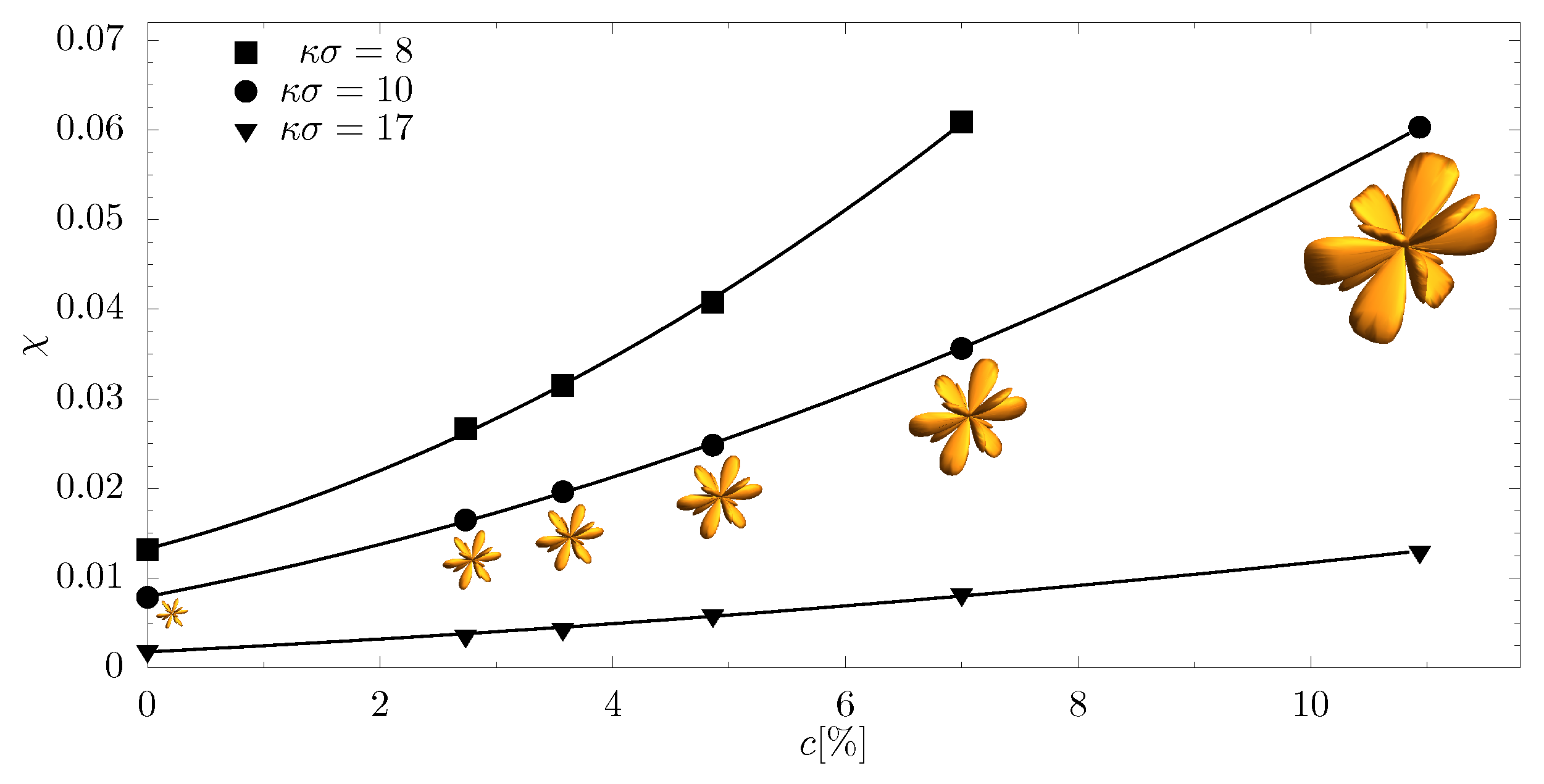High Partial Auxeticity Induced by Nanochannels in [111]-Direction in a Simple Model with Yukawa Interactions
Abstract
:1. Introduction
2. Model, Method and Computation Details
2.1. The Model
2.2. Method
2.3. Computational Details
3. Results and Discussion
3.1. Elastic Compliances and Symmetry of the System
3.2. Size Effects
3.3. Poisson’s Ratio
3.4. The Degree of Auxeticity
4. Conclusions
Supplementary Materials
Author Contributions
Funding
Acknowledgments
Conflicts of Interest
Abbreviations
| MC | Monte Carlo |
| HS | Hard Sphere |
| HCRYP | Hard-Core Repulsive Yukawa Potential |
References
- Jones, R.M. Mechanics of Composite Materials, 2nd ed.; Francis & Taylor: Philadelphia, PA, USA, 1999. [Google Scholar]
- Stankovich, S.; Dikin, D.A.; Dommett, G.H.; Kohlhaas, K.M.; Zimney, E.J.; Stach, E.A.; Piner, R.D.; Nguyen, S.T.; Ruoff, R.S. Graphene-based composite materials. Nature 2006, 442, 282–286. [Google Scholar] [CrossRef] [PubMed]
- Rao, J.G.; Sinnur, K.H.; Jain, R.K. Effect of weave texture of carbon fabric on mechanical, thermal and tribological properties of carbon/carbon aircraft brakes. Int. J. Compos. Mater. 2015, 5, 89–96. [Google Scholar] [CrossRef]
- Davis, M.E. Ordered porous materials for emerging applications. Nature 2002, 417, 813–821. [Google Scholar] [CrossRef]
- Alderson, K.L.; Simkins, V.R.; Coenen, V.L.; Davies, P.J.; Alderson, A.; Evans, K.E. How to make auxetic fibre reinforced composites. Phys. Status Solidi B-Basic Solid State Phys. 2005, 242, 509–518. [Google Scholar] [CrossRef]
- Xianglong, Y.; Ji, Z.; Haiyi, L.; Zhengyi, J.; Lingling, W. Mechanical metamaterials associated with stiffness, rigidity and compressibility: A brief review. Prog. Mater. Sci. 2018, 94, 114–173. [Google Scholar]
- Lim, T.C. Analogies across auxetic models based on deformation mechanism. Phys. Status Solidi Rapid Res. Lett. 2017, 11, 1600440. [Google Scholar] [CrossRef]
- Ren, X.; Das, R.; Tran, J.P.; Ngo, T. Auxetic metamaterials and structures: A review. Smart Mater. Struct. 2018, 27, 023001. [Google Scholar] [CrossRef]
- Lakes, R.S. Foam structures with a negative Poisson’s ratio. Science 1987, 235, 1038–1040. [Google Scholar] [CrossRef]
- Wojciechowski, K.W. Two-dimensional isotropic model with a negative Poisson ratio. Phys. Lett. A 1989, 137, 60–64. [Google Scholar] [CrossRef]
- Evans, K.E.; Nkansah, M.A.; Hutchinson, I.J.; Rogers, S.C. Molecular network design. Nature 1991, 353, 124. [Google Scholar] [CrossRef]
- Baughman, R.H. Avoiding the shrink. Nature 2003, 425, 667. [Google Scholar] [CrossRef] [PubMed]
- Greaves, G.N.; Greer, A.L.; Lakes, R.S.; Rouxel, T. Poisson’s ratio and modern materials. Nat. Mater. 2011, 10, 823–837. [Google Scholar] [CrossRef]
- Lim, T.C. Auxetic Materials and Structures; Springer: Singapore, 2015. [Google Scholar] [CrossRef]
- Duncan, O.; Shepherd, T.; Moroney, C. Review of auxetic materials for sports applications: Expanding options in comfort and protection. Appl. Sci. Basel 2018, 8, 941. [Google Scholar] [CrossRef]
- Wang, Y.; Ding, Y. Mechanical and electronic properties of stoichiometric silicene and germanene oxides from first-principles. Phys. Status Solidi Rapid Res. Lett. 2013, 7, 410–413. [Google Scholar] [CrossRef]
- Ho, D.T.; Kim, H.; Kwon, S.Y.; Kim, S.Y. Auxeticity of face–centered cubic metal (001) nanoplates. Phys. Status Solidi B-Basic Solid State Phys. 2015, 252, 1492–1501. [Google Scholar] [CrossRef]
- Azzopardi, K.M.; Brincat, J.P.; Grima, J.N.; Gatt, R. Advances in the study of the deformation mechanism of stishovite. Phys. Status Solidi B-Basic Solid State Phys. 2015, 252, 1486–1491. [Google Scholar] [CrossRef]
- Baimova, J.A.; Rysaeva, L.K.; Liu, B.; Dmitriev, S.V.; Zhou, K. From flat graphene to bulk carbon nanostructures. Phys. Status Solidi B-Basic Solid State Phys. 2015, 252, 1502–1507. [Google Scholar] [CrossRef]
- Grima, J.N.; Zerafa, C.; Brincat, J.P. Development of novel poly(phenylacetylene) network polymers and their mechanical behaviour. Phys. Status Solidi B-Basic Solid State Phys. 2014, 251, 375–382. [Google Scholar] [CrossRef]
- Grima, J.N.; Zerafa, C. On the effect of solvent molecules on the structure and mechanical properties of organic polyphenylacetylene auxetic re-entrant network polymers. Phys. Status Solidi B-Basic Solid State Phys. 2013, 250, 2030–2037. [Google Scholar] [CrossRef]
- Ho, D.T.; Park, S.; Kwon, S.; Han, T.; Kim, S.Y. Negative Poisson’s ratio in cubic materials along principal directions. Phys. Status Solidi B-Basic Solid State Phys. 2016, 253, 1288–1294. [Google Scholar] [CrossRef]
- Kolpakov, A.G. Determination of the average characteristics of elastic frameworks. J. Appl. Math. Mech. 1985, 49, 739–745. [Google Scholar] [CrossRef]
- Gibson, L.J.; Ashby, M.F. Cellular Solids, Structure and Properties; Cambridge University Press: Cambridge, UK, 1997. [Google Scholar]
- Mizzi, L.; Azzopardi, K.M.; Attard, D.; Grima, J.N.; Gatt, R. Auxetic metamaterials exhibiting giant negative Poisson’s ratios. Phys. Status Solidi Rapid Res. Lett. 2015, 9, 425–430. [Google Scholar] [CrossRef]
- Jensen, A.W.; Zhao, H.; Norbury, A.; Li, L.; Rothwell, G.; Ren, J. Effects of Poisson’s ratio on the deformation of thin membrane structures under indentation. Phys. Status Solidi B-Basic Solid State Phys. 2015, 252, 1526–1532. [Google Scholar] [CrossRef]
- Slann, A.; White, W.; Scarpa, F.; Boba, K.; Farrow, I. Cellular plates with auxetic rectangular perforations. Phys. Status Solidi B-Basic Solid State Phys. 2015, 252, 1533–1539. [Google Scholar] [CrossRef]
- Strek, T.; Jopek, H.; Nienartowicz, M. Dynamic response of sandwich panels with auxetic cores. Phys. Status Solidi B-Basic Solid State Phys. 2015, 252, 1540–1550. [Google Scholar] [CrossRef]
- Jopek, H.; Strek, T. Thermal and structural dependence of auxetic properties of composite materials. Phys. Status Solidi B-Basic Solid State Phys. 2015, 252, 1551–1558. [Google Scholar] [CrossRef]
- Mizzi, L.; Gatt, R.; Grima, J.N. Non-porous grooved single-material auxetics. Phys. Status Solidi B-Basic Solid State Phys. 2015, 252, 1559–1564. [Google Scholar] [CrossRef]
- Hoover, W.G.; Hoover, C.G. Searching for auxetics with DYNA3D and ParaDyn. Phys. Status Solidi B-Basic Solid State Phys. 2005, 242, 585–594. [Google Scholar] [CrossRef]
- Gatt, R.; Caruana-Gauci, R.; Attard, D.; Casha, A.R.; Wolak, W.; Dudek, K.; Mizzi, L.; Grima, J.N. On the properties of real finite-sized planar and tubular stent-like auxetic structures. Phys. Status Solidi B-Basic Solid State Phys. 2014, 251, 321–327. [Google Scholar] [CrossRef]
- Mizzi, L.; Attard, D.; Casha, A.; Grima, J.N.; Gatt, R. On the suitability of hexagonal honeycombs as stent geometries. Phys. Status Solidi B-Basic Solid State Phys. 2014, 251, 328–337. [Google Scholar] [CrossRef]
- Rodriguez, B.; Kalathur, H.; Lakes, R. A sensitive piezoelectric composite lattice: Experiment. Phys. Status Solidi B-Basic Solid State Phys. 2014, 251, 349–353. [Google Scholar] [CrossRef]
- Strek, T.; Jopek, H.; Maruszewski, B.T.; Nienartowicz, M. Computational analysis of sandwich-structured composites with an auxetic phase. Phys. Status Solidi B-Basic Solid State Phys. 2014, 251, 354–366. [Google Scholar] [CrossRef]
- Airoldi, A.; Bettini, P.; Panichelli, P.; Oktem, M.F.; Sala, G. Chiral topologies for composite morphing structures? Part I: Development of a chiral rib for deformable airfoils. Phys. Status Solidi B-Basic Solid State Phys. 2015, 252, 1435–1445. [Google Scholar] [CrossRef]
- Wang, Y.C.; Shen, M.W.; Liao, S.M. Microstructural effects on the Poisson’s ratio of star-shaped two-dimensional systems. Phys. Status Solidi B-Basic Solid State Phys. 2017, 254, 1700024. [Google Scholar] [CrossRef]
- Cauchi, R.; Attard, D.; Grima, J.N. On the mechanical properties of centro–symmetric honeycombs with T–shaped joints. Phys. Status Solidi B-Basic Solid State Phys. 2013, 250, 2002–2011. [Google Scholar] [CrossRef]
- Gatt, R.; Attard, D.; Farrugia, P.S.; Azzopardi, K.M.; Mizzi, L.; Brincat, J.P.; Grima, J.N. A realistic generic model for anti–tetrachiral systems. Phys. Status Solidi B-Basic Solid State Phys. 2013, 250, 2012–2019. [Google Scholar] [CrossRef]
- Khakalo, S.; Balobanov, V.; Niiranen, J. Modelling size-dependent bending, buckling and vibrations of 2D triangular lattices by strain gradient elasticity models: Applications to sandwich beams and auxetics. Int. J. Eng. Sci. 2018, 127, 33–52. [Google Scholar] [CrossRef]
- Nguyen, C.; Maheshwari, V.; Saraf, R.F. Ultrasoft 100 nm Thick Zero Poisson’s Ratio Film with 60% Reversible Compressibility. Nano Lett. 2012, 12, 2171. [Google Scholar] [CrossRef]
- Wang, Y.B.; Sotzing, G.A.; Weiss, R.A. Porous composites coated with hybrid nano carbon materials perform excellent electromagnetic interference shielding. Chem. Mater. 2003, 15, 375. [Google Scholar] [CrossRef]
- Chen, Y.J.; Li, Y.; Chu, B.T.T.; Kuo, I.T.; Yip, M.C.; Tai, N. Porous composites coated with hybrid nano carbon materials perform excellent electromagnetic interference shielding. Compos. Part B 2015, 70, 231. [Google Scholar] [CrossRef]
- Zhang, X.C.; Scarpa, F.; McHale, R.; Limmack, A.P.; Peng, H.X. Carbon nano-ink coated open cell polyurethane foam with micro-architectured multilayer skeleton for damping applications. RSC Adv. 2016, 6, 80334. [Google Scholar] [CrossRef]
- Tretiakov, K.V.; Piglowski, P.M.; Hyzorek, K.; Wojciechowski, K.W. Enhanced auxeticity in Yukawa systems due to introduction of nanochannels in [001]-direction. Smart Mater. Struct. 2016, 25, 054007. [Google Scholar] [CrossRef]
- Piglowski, P.M.; Wojciechowski, K.W.; Tretiakov, K.V. Partial auxeticity induced by nanoslits in the Yukawa crystal. Phys. Status Solidi-Rapid Res. Lett. 2016, 10, 566–569. [Google Scholar] [CrossRef]
- Demirors, A.F.; Pillai, P.P.; Kowalczyk, B.; Grzybowski, B.A. Colloidal assembly directed by virtual magnetic moulds. Nature 2013, 503, 99–103. [Google Scholar] [CrossRef] [PubMed]
- Azhar, F.E.; Baus, M.; Ryckaert, J.P. Line of triple points for the hard-core Yukawa model: A computer simulation study. J. Chem. Phys. 2000, 112, 5121–5126. [Google Scholar] [CrossRef]
- Auer, S.; Frenkel, D. Crystallization of weakly charged colloidal spheres: a numerical study. J. Phys.-Condes. Matter 2002, 14, 7667–7680. [Google Scholar] [CrossRef] [Green Version]
- Hynninen, A.P.; Dijkstra, M. Phase diagrams of hard-core repulsive Yukawa particles. Phys. Rev. E 2003, 68, 021407. [Google Scholar] [CrossRef] [PubMed]
- Hansen, J.P.; McDonald, I.R. Theory of Simple Liquids; Academic Press: Amsterdam, The Netherlands, 2006. [Google Scholar]
- Colombo, J.; Dijkstra, M. Effect of quenched size polydispersity on the fluid-solid transition in charged colloidal suspensions. J. Chem. Phys. 2011, 134, 154504. [Google Scholar] [CrossRef] [Green Version]
- Heinen, M.; Holmqvist, P.; Banchio, A.J.; Nagele, G. Pair structure of the hard-sphere Yukawa fluid: An improved analytic method versus simulations, Rogers-Young scheme, and experiment. J. Chem. Phys. 2011, 134, 044532. [Google Scholar] [CrossRef] [Green Version]
- Van der Linden, M.N.; van Blaaderen, A.; Dijkstra, M. Effect of size polydispersity on the crystal-fluid and crystal-glass transition in hard-core repulsive Yukawa systems. J. Chem. Phys. 2013, 138, 114903. [Google Scholar] [CrossRef] [Green Version]
- Alder, B.J.; Wainwright, T.E. Phase Transition for a Hard Sphere System. J. Chem. Phys. 1957, 27, 1208–1209. [Google Scholar] [CrossRef]
- Tretiakov, K.V.; Wojciechowski, K.W. Poisson’s ratio of the fcc hard sphere crystal at high densities. J. Chem. Phys. 2005, 123, 074509. [Google Scholar] [CrossRef] [PubMed]
- Tretiakov, K.V.; Wojciechowski, K.W. Partially auxetic behavior in fcc crystals of hard-core repulsive Yukawa particles. Phys. Status Solidi B-Basic Solid State Phys. 2014, 251, 383–387. [Google Scholar] [CrossRef]
- Piglowski, P.M.; Narojczyk, J.W.; Poźniak, A.A.; Wojciechowski, K.W.; Tretiakov, K.V. Auxeticity of Yukawa systems with nanolayers in the (111) crystallographic plane. Materials 2017, 10, 1338. [Google Scholar] [CrossRef] [PubMed]
- Tretiakov, K.V.; Piglowski, P.M.; Narojczyk, J.W.; Wojciechowski, K.W. Selective enhancement of auxeticity through changing a diameter of nanochannels in Yukawa systems. Smart Mater. Struct. 2018, 27, 115021. [Google Scholar] [CrossRef]
- Parrinello, M.; Rahman, A. Polymorphic transitions in single crystals: A new molecular dynamics method. J. Appl. Phys. 1981, 52, 7182–7190. [Google Scholar] [CrossRef]
- Parrinello, M.; Rahman, A. Strain fluctuations and elastic constants. J. Chem. Phys. 1982, 76, 2662–2666. [Google Scholar] [CrossRef]
- Wojciechowski, K.W.; Branka, A.C.; Parrinello, M. Monte Carlo study of the phase diagram of a two dimensional system of hard cyclic hexamers. Mol. Phys. 1984, 53, 1541–1545. [Google Scholar] [CrossRef]
- Wojciechowski, K.W.; Tretiakov, K.V.; Kowalik, M. Elastic properties of dense solid phases of hard cyclic pentamers and heptamers in two dimensions. Phys. Rev. E 2003, 67, 036121. [Google Scholar] [CrossRef] [PubMed]
- Tokmakova, S.P. Stereographic projections of Poisson’s ratio in auxetic crystals. Phys. Status Solidi B-Basic Solid State Phys. 2005, 242, 721–729. [Google Scholar] [CrossRef]
- Piglowski, P.M.; Narojczyk, J.W.; Wojciechowski, K.W.; Tretiakov, K.V. Auxeticity enhancement due to size polydispersity in fcc crystals of hard-core repulsive Yukawa particles. Soft Matter 2017, 13, 7916–7921. [Google Scholar] [CrossRef]
- Nye, J.F. Physical Properties of Crystalls, Their Representation by Tensors and Matrices; Clarendon Press: Oxford, UK, 1957. [Google Scholar]







| n | NHS = | c | |
|---|---|---|---|
| 4 | 256 | 28 | |
| 5 | 500 | 35 | |
| 6 | 864 | 42 | |
| 7 | 1372 | 49 | |
| 8 | 2048 | 56 |
© 2018 by the authors. Licensee MDPI, Basel, Switzerland. This article is an open access article distributed under the terms and conditions of the Creative Commons Attribution (CC BY) license (http://creativecommons.org/licenses/by/4.0/).
Share and Cite
Tretiakov, K.V.; Pigłowski, P.M.; Narojczyk, J.W.; Bilski, M.; Wojciechowski, K.W. High Partial Auxeticity Induced by Nanochannels in [111]-Direction in a Simple Model with Yukawa Interactions. Materials 2018, 11, 2550. https://doi.org/10.3390/ma11122550
Tretiakov KV, Pigłowski PM, Narojczyk JW, Bilski M, Wojciechowski KW. High Partial Auxeticity Induced by Nanochannels in [111]-Direction in a Simple Model with Yukawa Interactions. Materials. 2018; 11(12):2550. https://doi.org/10.3390/ma11122550
Chicago/Turabian StyleTretiakov, Konstantin V., Paweł M. Pigłowski, Jakub W. Narojczyk, Mikołaj Bilski, and Krzysztof W. Wojciechowski. 2018. "High Partial Auxeticity Induced by Nanochannels in [111]-Direction in a Simple Model with Yukawa Interactions" Materials 11, no. 12: 2550. https://doi.org/10.3390/ma11122550





